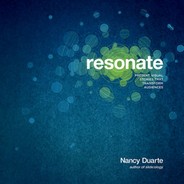
90
Case Study: General Electric
Showing the Benefit of Change
As one of the largest organizations in the world, General Electric
places tremendous value on innovation. They solve today’s problems
while imagining new innovations that shape the future. Admittedly, in
this process, yesterday’s innovations are obsolesced by tomorrow’s
needs. The organization is constantly in a state of flux between what
is and what could be.
Communicating within this atmosphere of innovative tension isn’t
always easy. Chief marketing officer, Beth Comstock, has led a team
that has navigated this territory effectively. Many of Comstock’s pre-
sentations address the contrast of what is versus what could be.
Comstock coupled her contrasting words with
contrasting images to amplify her message.
CH004.indd 90CH004.indd 90 8/16/10 4:06:10 PM8/16/10 4:06:10 PM

Define the Journey 91
Growth in a Downturn?
Jeff Immelt took over as CEO of GE in 2001 with a strategy
to grow the company from within while investing more in
technology/innovation, global expansion, and customer
relationships. To make this happen, GE needed a stronger
marketing organization to sit beside technology, sales,
and the regional business leaders. For decades, GE was so
confident in its products that it believed the products could
practically market themselves. Then, a collective awakening
occurred: Seasoned marketers could push GE to go more
places, organize technologies to accomplish new feats, and
help point the company in the direction of even more sales.
GE set an aggressive course in 2003 to double its market-
ing talent and build new capabilities. Comstock was brought
on as the first CMO in decades. GE marketers established
a marketing-led innovation portfolio and process across
GE that creates between $2 and $3 billion a year in new
revenue. Through this effort, GE defined marketing inno-
vation as a necessary partner for technical and product
Comstock delivered the presentation featured on the next
few pages to persuade her sales and marketing team that
“growth in a downturn” is possible (notice the contrast
even in her title). She wanted to move her team from the
defeatist mindset of a downturn (what is) to believing they
could innovate in a downturn (what could be). It’s common
for her presentations to address the theme of navigating
through the tension of innovation.
Comstock sprinkles her communication with personal
stories of risk, frailty, and victories, which makes her cred-
ible and transparent. She once even shared how previous
innovation. Marketers were a critical part of the team that
drove 8 to 10 percent organic growth—more than double
the historic rate.
But by 2008, a global economic crisis was wreaking havoc
on growth rates and changing customer behavior. What
happens when growth stalls? Was it time for GE to cut
marketing? The decision was just the opposite. Marketing
needed to be valued as a function for all seasons.
Comstock was inspired by research conducted by Harvard
Business School’s Ranjay Gulati. Gulati observed that compa-
nies that relentlessly focus on the customer and invest more
in the pipeline in a downturn can expect to stay ahead for up
to five years after recovery. Now that gets your attention!
GE’s goal in 2008 was to stay focused on growth, no matter
how tough the environment. GE needed to plant seeds so
it would be poised when recovery happened. That meant
investing in new opportunities and encouraging new ideas.
GE CEO Jack Welch called her only to hang up the phone
midsentence. When Comstock called his assistant, she
was told, “He’s teaching you a lesson—that’s how you come
across sometimes.” It was a stark lesson about leading and
coaching with humor.
Comstock is a natural at communicating contrast. The setup
of her presentation is below. The content has been edited on
the following pages into a “move from,” “move to,” “benefit,”
and “personalized story” matrix so you can see the brilliant,
underlying structure she inherently used.
CH004.indd 91CH004.indd 91 8/16/10 4:06:37 PM8/16/10 4:06:37 PM

92 Resonate
Foster Creativity Navigate Ambiguity Take Risks
Move to Being
Move from being uncomfortable with
creativity to believing that everyone can
be creative—it’s frightening to move
outside a comfort zone.
Move to Being
Move from being paralyzed by not
knowing all the answers to accept-
ing that you will never know all
the answers.
Move to Being
Move from being afraid of instigat-
ing ideas to fighting for a better way.
Instigators are rarely welcomed but
are critical to the creative process.
Move to Doing
Move from chaotic to organized through
“freedom within a framework.” Define the
problem, make room for ideas, and work
as individuals and teams.
Move to Doing
Move from fear of starting to pick-
ing a path, knowing that where you
end up could be very different than
where you started.
Move to Doing
Move from low visibility to moving
forward without the answers. Ideas
need a champion to turn them into
action, so executive buy-in is critical.
Benefit/Outcome
Creativity takes planning in multiple itera-
tions, but good process helps ideas stick
and energizes the team.
Benefit/Outcome
Removing ambiguity helps you face
reality, make the tough calls, and be
flexible with new approaches.
Benefit/Outcome
If you do not jump in, you will regret
the missed opportunity. When you
fail fast, you fail small.
Personalize
A team of nuclear scientists went behind
the scenes at NASCAR to learn simi-
larities in the way race cars and nuclear
plants are serviced. For me, keeping an
idea journal is a helpful way to create a
“space” to ideate.
Personalize
Jack Welch taught me the impor-
tance of wallowing. Having spent
many years in fast-paced news
environments, Jack taught me how
to get to know ideas and people.
Personalize
I needed to overcome my reserve.
Sometimes I look back to when I was
reluctant even when I knew I could
add value, then regret the missed
opportunity. Now I tell myself, “You
don’t want to miss this. Get in there.”
CH004.indd 92CH004.indd 92 8/16/10 4:06:38 PM8/16/10 4:06:38 PM

Define the Journey 93
Develop New World Skills Empower Teams Unleash Your Passion
Move to Being
Move from being a technophobe to
seeing that in a networked world, value
comes from who you are connected to.
Move to Being
Move from going it alone to form-
ing partnerships, because teams
with multiple points of view create
diverse solutions.
Move to Being
Move from lacking passion to
encouraging passion—yours and
theirs. Lack of passion stalls ideas,
so start and end with passion.
Move to Doing
Move from the illusion of control to invit-
ing others to join with you. Your best
selling machine can be validation from
customers in your network.
Move to Doing
Move from fear of criticism to recog-
nizing tension as an important part
of the creative process. Give critics a
voice, and they’ll become advocates.
Move to Doing
Move from personal passion to
shared passion blended with com-
passion—it creates an energy that
propels projects and meets needs.
Benefit/Outcome
Transform your sphere of influence
and turn your network into an asset
that predicts future actions, needs,
and solutions.
Benefit/Outcome
Partnerships allow you to share
risk, fill in capability gaps, and
focus expertise.
Benefit/Outcome
You create an energy that builds on
itself, that creates momentum and
engagement from others.
Personalize
The Obama campaign understood the
power of a decentralized network of
people who shared a passion for change
in the political systems. They were given
access to key tools, information, and the
freedom to use them.
Personalize
I believed I had to do it all myself
and didn’t ask for help. I learned
that you have to invite others in and
that it’s okay to admit you need
help. People want to help and be
part of something bigger
than themselves.
Personalize
I’ve learned that sometimes my pas-
sion can overwhelm others, espe-
cially if it borders on aggressiveness.
I’ve had to let ideas germinate and
encourage others to add to them
and make them their own.
CH004.indd 93CH004.indd 93 8/16/10 4:07:15 PM8/16/10 4:07:15 PM
94 Resonate
Most audience members are comfortable with the view from their own
perspective and don’t like to admit there might be another valid perspective
out there. When you propose your idea, it forces them to make a decision
to either adopt your idea or live with the consequence of refusing to adopt
your idea.
To ensure your idea is adopted, it’s important to have a plan—a definitive
destination. Determining the destination involves creating a big idea (with
the stakes articulated). You also need to plan out the audience journey of
where you want them to move from and where you want them to move to.
They will possibly (okay, most definitely) initially react to your proposed
change with resistance. Address the resistance and risks involved so their
fears are pacified and they are willing to jump in.
Make sure the benefit is clear to them. You’re persuading them to change,
and there has to be something in it for them, their organization, or mankind
to make it worthwhile.
CH004.indd 94CH004.indd 94 8/16/10 4:07:35 PM8/16/10 4:07:35 PM
..................Content has been hidden....................
You can't read the all page of ebook, please click here login for view all page.
